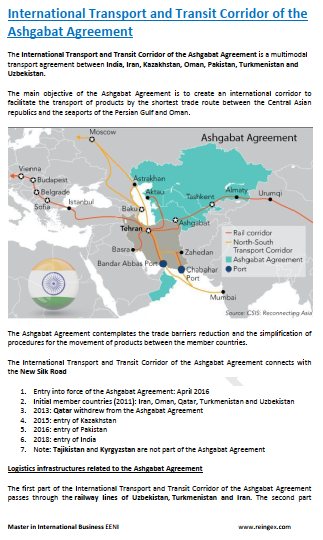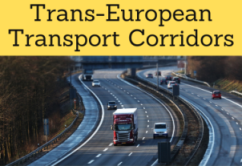Ashgabat Agreement (Transport Corridor, India)

International Transport and Transit Corridor of the Ashgabat Agreement
- Introduction to the International Transport and Transit Corridor of the Ashgabat Agreement
- Member countries of the Ashgabat Agreement: India, Iran, Kazakhstan, Oman, Pakistan, Turkmenistan and Uzbekistan
- Main features of the International Transport and Transit Corridor of the Ashgabat Agreement
- The integration with the
- The corridor and the New Silk Road
Sample - International Transport and Transit Corridor of the Ashgabat Agreement


The Subject «International Transport and Transit Corridor of the Ashgabat Agreement» belongs to the following Online Programs taught by EENI Global Business School:
Transportation Courses: Road, Railway, Multimodal.

Diploma: International Transport.

Masters: International Transport, International Business.
Doctorate: Global Logistics, Islamic Business, World Trade.
Languages:  .
Summary in
.
Summary in  Corredor del Acuerdo de Asjabad
Corredor del Acuerdo de Asjabad
 Corridor de l'Accord d'Achgabat
Corridor de l'Accord d'Achgabat  Corredor do Acordo de Asgabate.
Corredor do Acordo de Asgabate.
The International Transport and Transit Corridor of the Ashgabat Agreement is a multimodal transport agreement between India, Iran, Kazakhstan, Oman, Pakistan, Turkmenistan and Uzbekistan.
The main objective of the Ashgabat Agreement is to create an international corridor to facilitate the transport of products by the shortest trade route between the Central Asian republics and the
seaports of the Persian Gulf and Oman.
The Ashgabat Agreement contemplates the trade barriers reduction and the simplification of procedures for the movement of products between the member
countries.
The International Transport and Transit Corridor of the Ashgabat Agreement connects with the New Silk Road
- Entry into force of the Ashgabat Agreement: April 2016
- Initial member countries (2011): Iran, Oman, Qatar, Turkmenistan and Uzbekistan
- 2013: Qatar withdrew from the Ashgabat Agreement
- 2015: entry of Kazakhstan
- 2016: entry of Pakistan
- 2018: entry of India
- Note: Tajikistan and Kyrgyzstan are not part of the Ashgabat Agreement
Logistics infrastructures related to the Ashgabat Agreement.
The first part of the International Transport and Transit Corridor of the Ashgabat Agreement passes through the railway lines of Uzbekistan, Turkmenistan and Iran. The second part passes through the routes that connect the Bender Abbas port and the Chahbahar port (Iran) with the port of the Sultanate of Oman.
- Turkmenistan-Afghanistan-Tajikistan Railway Line (TAT)
- Afghanistan-Turkmenistan-Azerbaijan-Georgia-Turkey transport corridor
- Iran-Turkmenistan-Kazakhstan railway
- Chabahar Port
- Transport Corridor Europe-Caucasus-Asia (TRACECA)
- International North-South Transport Corridor
- Trans-Caspian Railway
- Highway between India, Russia, Iran, Europe and Central Asia
Asian regional economic communities related to the International Transport and Transit Corridor of the Ashgabat Agreement
- Central Asia Cooperation (CAREC): Afghanistan, Azerbaijan, China, Kazakhstan, Kyrgyzstan, Mongolia, Pakistan, Tajikistan, Turkmenistan and Uzbekistan. Iran is an observer country
- Economic Cooperation Organization (ECO): Afghanistan, Azerbaijan, Iran, Kazakhstan, Kyrgyzstan, Pakistan, Tajikistan, Turkey, Turkmenistan and Uzbekistan
- Shanghai Cooperation Organization: Kazakhstan, China, Kyrgyzstan, Russia, Tajikistan and Uzbekistan
- Commonwealth of Independent States: Armenia, Azerbaijan, Belarus, Kazakhstan, Kyrgyzstan, Moldova, Russia, Ukraine, Tajikistan, Turkmenistan and Uzbekistan
- Organization for Cooperation between Railways (OSJD): Azerbaijan, Albania, Afghanistan, Belarus, Bulgaria, Hungary, Vietnam, Georgia, Iran, Kazakhstan, China, North Korea, South Korea, Cuba, Kyrgyzstan, Latvia, Lithuania, Moldova, Mongolia, Poland, Russia, Romania, Slovakia, Tajikistan, Turkmenistan, Uzbekistan, Ukraine, Czech Republic and Estonia
- Asian Clearing Union: Bangladesh, Bhutan, India, Iran, Myanmar, Maldives, Nepal, Pakistan and Sri Lanka
- South Asian Association for Regional Cooperation: Afghanistan, Bangladesh, Bhutan, India, Maldives, Nepal, Pakistan and Sri Lanka
- Iran, Oman and India are members of the Indian-Ocean Rim Association
- Kazakhstan is a member of
- Eurasian Economic Union
- Cooperation Council of Turkic Speaking States
- Oman is a member of the Gulf Cooperation Council (GCC)
- India is a member of:
Main Euro-Asian institutions related to the Corridor
- Boao Forum for Asia
- Asia Cooperation Dialogue
- ESCAP
- Asian Development Bank
- Colombo Plan
Major Islamic institutions related to the corridor
- OCI
- Islamic Development Bank
The main Religions of the region of the International Transport and Transit Corridor of the Ashgabat Agreement are:
The International Transport and Transit Corridor of the Ashgabat Agreement belongs to the:

Related Corridors to the Silk Road
- Bangladesh-Myanmar Corridor
- Asia-Africa Corridor
- Almaty-Bishkek Corridor
- China-Russia Corridor
- China-Central-West Asia Corridor
- China-Pakistan Corridor
- Trans-Caspian Corridor
- Nanning-Singapore Corridor
- Kyrgyzstan-Iran Corridor


Related Trade Agreements
- Iran
- Trade Agreements of Iran: Algeria, Armenia, Syria, Venezuela, Pakistan
- India
- Indian Trade Agreements: Sri Lanka, Thailand, Indonesia, Singapore, ASEAN, South Korea, the EU, New Zealand, Africa-India, Mauritius, Canada, Australia, GCC, SACU, EFTA, MERCOSUR, Andean Community
- Kazakhstan
- Customs Union with Russia and Belarus
- Trade Agreements with Armenia, Ukraine and Georgia
- Enhanced Partnership and Cooperation Agreement with the European Union
- Turkmenistan
- Trade Agreements with Armenia, Georgia and with the Eurasian Economic Union
- Uzbekistan
- Trade Agreements with Kyrgyzstan, Ukraine, Georgia and with the Eurasian Economic Union
- Oman
- US-Oman Agreement
- Trade Agreements (as a member of the Cooperation Council of the Gulf) with the EU, India, Australia, Singapore, Syria, EFTA..
- Iran-Pakistan Preferential trade agreement
- Preferential Trade Area with Mauritius
- Trade Agreements with Sri Lanka, India, ASEAN, China, Bangladesh, MERCOSUR
(c) EENI Global Business School (1995-2024)
We do not use cookies
Top of this page



